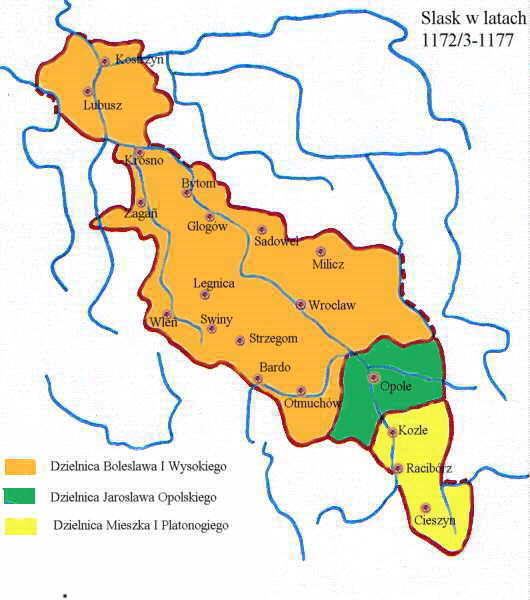 | ||
The Duke of Silesia was the sons and descendants of the Polish Duke Bolesław III Wrymouth. In accordance with the last will and testament of Bolesław, upon his death his lands were divided into four or five hereditary provinces distributed among his sons, and a royal province of Kraków reserved for the eldest, who was to be High Duke of all Poland. This was known as the fragmentation of Poland. Subsequent developments lead to further splintering of the duchies.
Contents
- Duchy of Silesia
- Partitions of Silesia
- Lower Silesia
- Dukes of Lower Silesia
- Upper Silesia
- Dukes of Upper Silesia
- Ecclesiastical Duchy of Nysa
- Sites
- References
At the beginning of the 14th century, fourteen independent Duchies existed in Silesia: Brzeg, Wrocław, Świdnica, Jawor, Ziębice, Głogów, Ścinawa, Żagan and Oleśnica in Lower Silesia; Koźle, Cieszyn, Bytom, Niemodlin, Opole, Strzelce, Racibórz and Opava in Upper Silesia and the eclessiatical duchy of Nysa. Between 1327 and 1329 most dukes accepted the overlordship of Bohemian king John of Bohemia, who acquired the right of succession for all of these duchies. In the coming centuries all branches of the Silesian Piasts died out, and with the death of George William, Duke of Liegnitz the dynasty ceased to exist.
Duchy of Silesia
The Duchy of Silesia, one of the hereditary provinces of Poland, Silesia, was granted to Bolesław III's eldest son, Władysław II the Exile, and was subsequently divided among his sons Bolesław I the Tall (Wrocław/Lower Silesia), Mieszko I Tanglefoot (Racibórz/Upper Silesia) and Konrad Spindleshanks (Głogów). After Konrad's death Głogów was again united with the Duchy of Wrocław/Lower Silesia.
Partitions of Silesia
In 1173 Bolesław returned and he agreed to let Mieszko and Bolesław rule in their own Duchies, separated from the Duchy of Silesia. This led to the creation of the Duchy of Racibórz for Mieszko I and the Duchy of Opole for Jarosław, beginning the fragmentation of the Duchy of Silesia. The territories controlled by Mieszko I and Jarosław roughly corresponded to what is known as Upper Silesia, while the territories remaining with Bolesław I roughly corresponded to Lower Silesia.
Lower Silesia
Duchy of Lower Silesia was a direct continuation of the Duchy of Silesia, but without the territories roughly corresponding to Upper Silesia; hence it was composed of the territories roughly corresponding to Lower Silesia. Some sources refer to it as the Duchy of Silesia; some as Duchy of Lower Silesia; others yet as the Duchy of Wrocław (Breslau). Wrocław was the capital of the Duchy of Silesia, yet this early (1172–1248) Duchy of Silesia should not be confused with the smaller Duchy of Wrocław that was created with further fragmentation in 1248. The Duchy went through various border changes in the coming years, sometimes losing and sometimes gaining territory. In 1248 Lower Silesia was divided when Bolesław II had to cede the Duchy of Wrocław to his younger brother Henry III.
Duchy of Lower Silesia
In 1248, the Duchy of Lower Silesia was partitioned in the duchies of Wrocław and Legnica.
Duchy of Wrocław Duchy of Legnica
In 1251, in Lower Silesia, the Duchy of Glogów emerged from Wrocław.
In 1274, the Duchy of Świdnica-Jawor emerged from Legnica. In the same year, the Duchy of Zágán emerged from Glogów.
Duchy of Świdnica-Jawor Duchy of Żagań
In 1311,the Duchy of Brzeg emerged from Legnica.
In 1313, the Duchy of Oleśnica emerged from Glógow.
In 1322, the Duchy of Ziebice emerged from Swidnica-Jawor.
Dukes of Lower Silesia
Piast Dynasty
Upper Silesia
Upper Silesia was divided into the Duchies of Cieszyn, and Opole-Racibórz. In 1340 the Duchy of Racibórz was united with Opava, a Bohemian fief.
In 1281, the Duchy of Cieszyn is created.
In 1282, the Duchies of Opole and Racibórz were created from the partition of the Duchy of Opole-Racibórz. With this partition, it was created also the Duchy of Bytom.
Duchy of Opole Duchy of Racibórz Duchy of Bytom
In 1315, the Duchy of Oświęcim emerged from the Duchy of Cieszyn.
In 1445, the Duchy of Zator emerged from the Duchy of Oświęcim.
Duchy of Zator
Dukes of Upper Silesia
Piast Dynasty
Ecclesiastical Duchy of Nysa
Established in 1290 by High Duke Henry IV Probus, held by the Bishops of Wrocław
Major part annexed by the Kingdom of Prussia after the First Silesian War in 1742.
Prussian part secularised in 1810.
Theocracy abolished in 1850.
Sites
http://www.tacitus.nu/historical-atlas/regents/poland/silesia.htm
